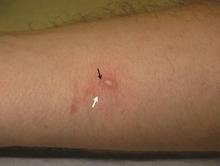Article
Vestibular Papillomatosis: A Benign Condition Mimicking Genital Warts
Vestibular papillomatosis (VP) is a benign condition of the female genitalia that may be mistaken for condyloma acuminatum (genital warts).
Shivani Nanda, MD; Peter A. Lio, MD
From the Department of Dermatology, Northwestern University Feinberg School of Medicine, Chicago, Illinois.
The authors report no conflict of interest.
Correspondence: Peter A. Lio, MD, 1455 N Milwaukee, 2nd Floor, Chicago, IL 60622 (p-lio@northwestern.edu).

Cutaneous warts are benign proliferations of the epidermis that occur secondary to human papillomavirus infection. The diagnosis of cutaneous warts is generally based on clinical appearance. Occasionally subtle lesions, particularly those of verruca plana, escape clinical identification leading to incomplete treatment and spreading. The authors propose that gentle painless sprays of liquid nitrogen to areas with suspicious lesions can help confirm the presence of subtle warts through cryotherapy-induced epithelial whitening.
To the Editor:
Cutaneous warts are benign proliferations of the epidermis that occur secondary to human papillomavirus (HPV) infection. The diagnosis of cutaneous warts is generally based on clinical appearance. Occasionally subtle lesions, particularly those of verruca plana, escape clinical identification leading to incomplete treatment and spreading. The acetic acid test (sometimes called the acetic acid visual inspection) causes epithelial whitening of HPV-infected areas after application of a 3% to 5% aqueous solution of acetic acid and has been used to detect subclinical HPV infection.1 Although the acetic acid test can support the diagnosis of cutaneous warts, it is more effective at detecting hyperplastic rather than flat warts and may be cumbersome to use routinely.2 We describe a simple clinical maneuver to help confirm the presence of subtle warts using gentle liquid nitrogen cryotherapy to induce epithelial whitening in areas of HPV infection.
A 22-year-old man presented for evaluation of a 5-mm verrucous papule on the right wrist. He was diagnosed with verruca vulgaris. During treatment, small satellite verrucous papules were visualized by differential whitening from the surrounding uninfected skin (Figure). A brief light spray of liquid nitrogen cryotherapy (-196°C) was applied over areas containing suspicious lesions for confirmation. This acetowhitelike change from indirect collateral cryotherapy allowed for identification and treatment of these subtle warts.
 Differential enhancement of cutaneous warts immediately after a brief collateral spray of cryotherapy over the affected area and surrounding rim. This painless maneuver can be used for identification of subtle flat warts (black arrow) that may be difficult to see. Other warts (white arrow) are almost impossible to visualize without this technique.
Differential enhancement of cutaneous warts immediately after a brief collateral spray of cryotherapy over the affected area and surrounding rim. This painless maneuver can be used for identification of subtle flat warts (black arrow) that may be difficult to see. Other warts (white arrow) are almost impossible to visualize without this technique.
Cutaneous warts represent foci of epithelial proliferation, and acetowhite changes are thought to occur from extravasation of intracellular water with subsequent tissue whitening in areas of high nuclear density.3 Acetowhite epithelium also has been reported after other ablative wart therapies.4 Similarly, acetowhitelike changes after cryotherapy may be secondary to cellular dehydration from ice crystal formation,5 with HPV-infected areas demonstrating increased susceptibility to freezing because of increased cellular water content in areas of hyperkeratosis. In addition, it has been demonstrated that cryotherapy alters the composition of the epithelium by destroying neutral and acidic mucopolysaccharides, which may subsequently induce the characteristic acetowhitelike changes in the epithelium of cutaneous warts.6
We propose that gentle painless sprays of liquid nitrogen to areas with suspicious lesions can help confirm the presence of subtle warts through cryotherapy-induced epithelial whitening. Although this test is a valuable diagnostic pearl, it should be noted that cryotherapy may accentuate an area of hyperkeratosis from causes other than an HPV infection. As such, clinical judgment is required.
Vestibular papillomatosis (VP) is a benign condition of the female genitalia that may be mistaken for condyloma acuminatum (genital warts).
No abstract available.
Warts are benign intraepidermal neoplasms that are caused by infection with human papillomavirus and commonly affect children and adolescents. The...
